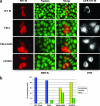Mutation of YMYL in the Nipah virus matrix protein abrogates budding and alters subcellular localization
- PMID: 17005661
- PMCID: PMC1676283
- DOI: 10.1128/JVI.01743-06
Mutation of YMYL in the Nipah virus matrix protein abrogates budding and alters subcellular localization
Abstract
Matrix (M) proteins reportedly direct the budding of paramyxoviruses from infected cells. In order to begin to characterize the assembly process for the highly lethal, emerging paramyxovirus Nipah virus (NiV), we have examined the budding of NiV M. We demonstrated that expression of the NiV M protein is sufficient to produce budding virus-like particles (VLPs) that are physically and morphologically similar to NiV. We identified in NiV M a sequence, YMYL, with similarity to the YPDL late domain found in the equine infectious anemia virus Gag protein. When the YMYL within NiV M was mutated, VLP release was abolished and M was relocalized to the nucleus, but the mutant M proteins retained oligomerization activity. When YMYL was fused to a late-domain mutant of the Ebola virus VP40 matrix protein, VP40 budding was restored. These results suggest that the YMYL sequence may act as a trafficking signal and a late domain for NiV M.
Figures





References
-
- Aguilar, H. C., K. A. Matreyek, C. M. Filone, S. T. Hashimi, E. L. Levroney, O. A. Negrete, A. Bertolotti-Ciarlet, D. Y. Choi, I. McHardy, J. A. Fulcher, S. V. Su, M. C. Wolf, L. Kohatsu, L. G. Baum, and B. Lee. 2006. N-glycans on Nipah virus fusion protein protect against neutralization but reduce membrane fusion and viral entry. J. Virol. 80:4878-4889. - PMC - PubMed
-
- Boge, M., S. Wyss, J. S. Bonifacino, and M. Thali. 1998. A membrane-proximal tyrosine-based signal mediates internalization of the HIV-1 envelope glycoprotein via interaction with the AP-2 clathrin adaptor. J. Biol. Chem. 273:15773-15778. - PubMed
Publication types
MeSH terms
Substances
Grants and funding
LinkOut - more resources
Full Text Sources

